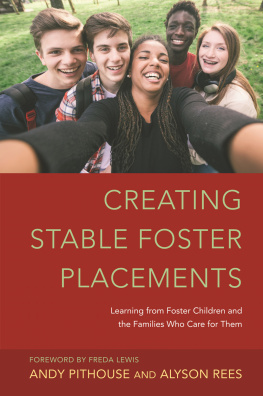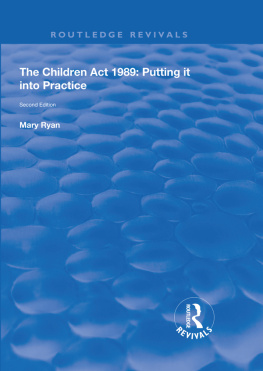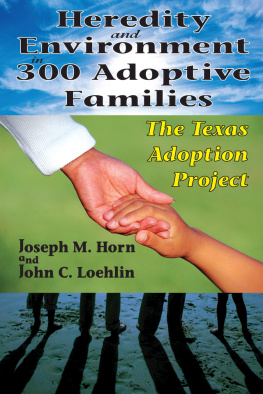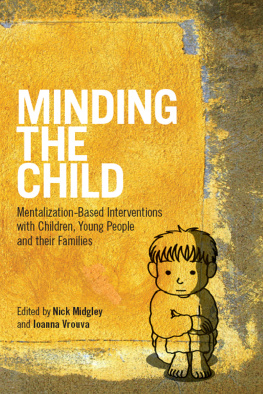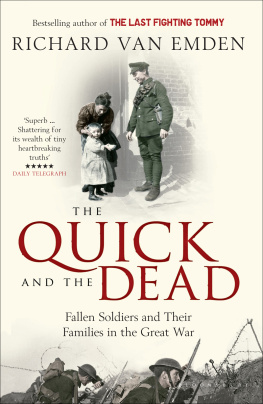CHILDREN GOING HOME
dartington social research series
Making Residential Care Work: Structure and culture in childrens homes
Elizabeth Brown, Roger Bullock, Caroline Hobson and Michael Little
Secure Treatment Outcomes: The care careers of difficult adolescents
Roger Bullock, Michael Little and Spencer Millham
Research in Practice: Experiments in Development and Information Design
Roger Bullock, Daniel Gooch, Michael Little and Kevin Mount
Children Going Home: The re-unification of families
Roger Bullock, Daniel Gooch and Michael Little
The Children Act 1989: Putting it into practice (2nd edition)
Mary Ryan
Children Going Home
THE RE-UNIFICATION OF FAMILIES
Roger Bullock
Daniel Gooch
Michael Little
Dartington Social Research Unit
First published 1998 by Ashgate Publishing
Reissued 2018 by Routledge
2 Park Square, Milton Park, Abingdon, Oxon OX14 4RN
711 Third Avenue, New York, NY 10017, USA
Routledge is an imprint of the Taylor & Francis Group, an informa business
Copyright Roger Bullock, Daniel Gooch, Michael Little 1998
All rights reserved. No part of this book may be reprinted or reproduced or utilised in any form or by any electronic, mechanical, or other means, now known or hereafter invented, including photocopying and recording, or in any information storage or retrieval system, without permission in writing from the publishers.
Notice:
Product or corporate names may be trademarks or registered trademarks, and are used only for identification and explanation without intent to infringe.
Publishers Note
The publisher has gone to great lengths to ensure the quality of this reprint but points out that some imperfections in the original copies may be apparent.
Disclaimer
The publisher has made every effort to trace copyright holders and welcomes correspondence from those they have been unable to contact.
A Library of Congress record exists under LC control number : 98034053
ISBN 13: 978-1-138-61362-1 (hbk)
ISBN 13: 978-0-429-46165-1 (ebk)
This study has been prepared by members of the Dartington Social Research Unit, Roger Bullock, Daniel Gooch and Michael Little. It would not have been possible without the active support of their colleagues at the Research Unit and the help of several local authorities and voluntary and independent organisations. We are extremely grateful, too, to the social workers, families and children who helped us with our task: we were made welcome, often at moments of uncertainty and anxiety, and it is only through their perseverance with our tedious requests that we were able to learn about issue of return.
The research was funded by the Department of Health and we would like to thank the Directors of Research and Development, Professor Sir Michael Peckham and Professor John Swales. The study would not have been possible without the assistance of the Social Care Division and the Social Services Inspectorate and we are grateful for their help. We have also benefited greatly from the research management undertaken by Dr Carolyn Davies.
Finally, we wish to thank colleagues in universities, local authorities and voluntary agencies who have advised, assisted and commented on our work. Particular thanks go to David Gordon for his statistical advice and to Michael Kelly for his typesetting skills.
This book brings up to date and extends the description of research first published by Dartmouth in 1993 as Going Home: The Return of Children Separated from their Families. The account of much of the earlier work is repeated here, but it is more than an ordinary revision of an old text: it reports on the extensive testing of a predictive model described in the closing chapters of the earlier book and, as a result, reaches rather different conclusions. It was felt that the new work deserved a new title; we hope we will not be accused of window dressing.
Since the Second World War, one of the most cogent issues to preoccupy those concerned with the care of children has been the best way to manage involuntary rifts between parents and children. Many previous studies have charted the effects of separation on children and the difficulties parents and wider family have in maintaining contact, particularly when the absence is long and stressful. Yet, despite this knowledge, there has been relatively little interest in the corollary of separation: return. As is so often the case with social systems, more emphasis has been given to entry than to exit.
Nonetheless, despite the paucity of research interest in return, getting children back home has long been an integral part of child-care. Fifty years ago, the evacuation of children from cities during the Blitz aroused great anxiety. The maintenance of links between families and absent loved-ones was very difficult. Telephones were few, letters often went astray and visits were almost impossible. Separation was also difficult to manage at an administrative level. Many of those who were subsequently to take key roles in the childrens departments of local authorities, created in 1948 as a consequence of the Curtis Report (HMSO, 1946), began their child-care careers coping with the tearful city children who arrived brown-labelled in the shire counties, Welsh valleys and sleepy West Country. These experts, along with a posse of wireless gurus whose broadcast chats enlivened many a damp evening in the Anderson shelter, all shared the pervading gloom that children evacuated to the countryside would soon lose touch with home and become rootless. Winnicott, Priestley and the Brains Trust joined with Lord Haw-Haw in a chorus of doom. For example, Winnicott (1984) warned mothers in a broadcast talk in 1945 that returning evacuees would be extremely difficult to manage.
What I want to say now is that when children come home they are not necessarily going to fall into and fit nicely into the holes that they made when they went away, for the simple reason that the hole has disappeared. Mother and child will have become able to manage without each other and when they meet they will have to start from scratch to get to know each other. This process must take time and time must be allowed. Its no use mother rushing up to the child and throwing her arms around his neck without looking to see whether he is going to be able to respond sincerely.
In a subsequent talk he emphasised that,
their return means that your life will be richer, but less your own. There will be few immediate rewards. At times, you will wish all of them back again in billets. Indeed, some children will have been so hurt by evacuation that it is beyond the power of parents to manage them.
This can hardly have been a welcome prospect for mothers also awaiting the return of husbands.
But like the maelstrom from which the children were rescued, so the consequences of evacuation seemed at first to be different from those first feared. Return was achieved by the vast majority. The widespread unease generated by separation was dismissed with official hindsight as an over-dramatisation from the well publicised behaviour of a few children entering Winnicotts clinic. Indeed, in the euphoria of peace it was emphasised that some children had the time of their lives and were much better cared for. Neither was there a catalogue of abuse and neglect inflicted by their frequently grudging hosts.


